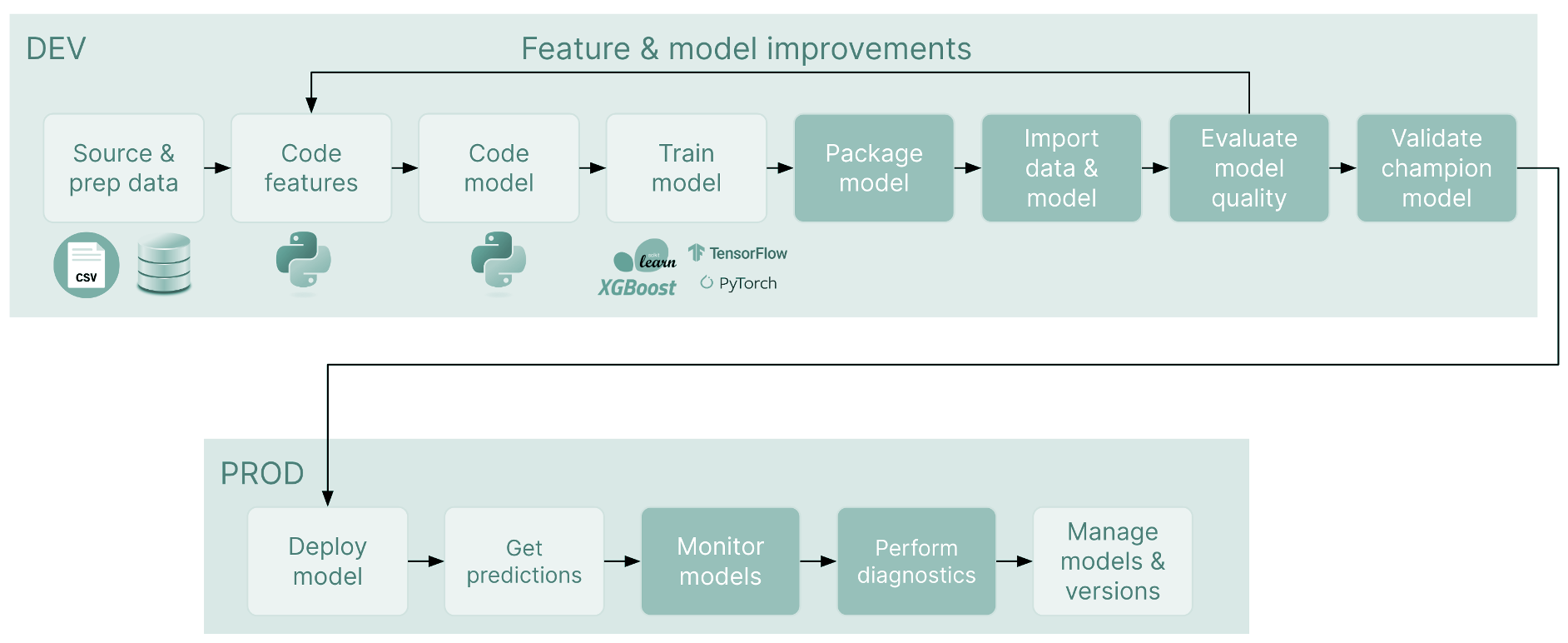Artificial Intelligence
The theory and development of computer systems capable of performing tasks that normally require human intelligence, such as visual perception, speech recognition, decision-making, and translation between languages.Welcome to TruEra!¶
Machine Learning
The use and development of computer systems that learn and adapt without following explicit instructions, by using algorithms and statistical models to analyze and draw inferences from patterns in data.A quick word about links in this documentation
You will be coming across three different kinds of links as you continue. Each is color-coded and serves a distinct purpose:
- blue (no underline) – links to (a) an anchor on the current page, (b) a different page, (c) a different website, or (d) a different window/tab
- green (dash underline) – opens a popup with additional information on the linked term. Click the × at the top-right of the popup content to close it and continue where you left off.
- orange (dash underline) – hover to reveal a short definition of the term or concept.
Otherwise, the navigator on the far left takes you to each link's respective content. Links in the Table of Contents on the far right take you to the subheading indicated within the same page.
Why TruEra?¶
Data Science
Engineering discipline tasked with developing methods and tools to analyze large amounts of information to determine what happened, why it happened, what will happen as a result, and what can be done about it.Machine Learning Operations
AI/ML engineering discipline focused on streamlining the process of taking machine learning models to production, and then maintaining and monitoring them.- Monitoring of your production models to let you know when issues arise beyond expected behavior, triggering real-time alerts with automatic email notifications to select members of your organization who need to know.
- Diagnostics for rapid evaluation during the model development process with a proven test harness, in addition to production RCA, when production monitoring identifies a poorly performing time segment.
Root Cause Analysis
A range of approaches, tools, and techniques used to uncover the root cause of a problem, identifying those factors that set in motion the entire cause-and-effect reaction that ultimately led to the problem(s).
As you build and deploy ML models, TruEra plugs into your ML stack to let you test, debug and monitor your projects to ensure each model is performing as expected. From feature development that helps you refine your data to efficiently training and evaluating your models to validating a final model for production, TruEra has you covered.

Moreover, TruEra is designed to work with a diverse set of stacks, supporting the most widely used Python modelling frameworks right out of the box — scikit-learn, XGBoost, LightGBM, CatBoost and others. In fact, TruEra can work with any and all of your models, whether they're custom-built by your team, built using DataRobot or Dataiku, or served by Sagemaker or Algorithmia.
But enough preamble. Let's dive right in.
How does it work?¶
The TruEra platform is designed to help you test, debug and monitor your model throughout its entire lifecycle. Rapid iterations are accelerated using a number of interface options — Python SDK, REST API, even a command line interface so you can define projects and then quickly import datasets, models, and metadata for ready evaluation with built-in diagnostics and visualization tools underpinning a flexible Web App UI designed to supercharge your modeling process and get to the ultimate objective — high quality models that work as intended.

TruEra in the Data Science Lifecycle¶
As illustrated below, the first phase of any model development and improvement process is initial data preparation, model development and training:
- sourcing and prepping the data
- selecting and engineering inputs
- selecting a model architecture and hyperparameter spaceThe set of all possible combinations of hyperparameters that can be used to train a machine learning model; hyperparameter values are used to control the learning process — i.e., data not derived via training.
- training the model
This is followed by packaging the model for TruEra platform introduction, importing the data and the model, then evaluating its quality and making adjustments for improvement. Throughout, TruEra Diagnostics provides continuous testing and debugging so that you know exactly where a model's weak spots are and how to improve those weaknesses, turning them into strengths.

Once you have a model you like, it's ready to be deployed to your production environment, where TruEra's monitoring support helps you drive the continuous improvement of all your deployed models.
To quickly get to the right guidance for your TruEra product license, click one of the buttons below or select an area of interest from the navigator on the left.
Otherwise, click Next below to continue.